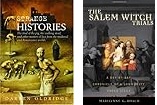Darren Oldridge. Strange Histories: the Trial of the Pig, the Walking Dead, and Other Matters of Fact from the Medieval and Renaissance Worlds. Routledge, 2005.
Marilynne K Roach. Salem Witch Trials: a Day by Day Chronicle of a Community Under Siege. Taylor Trade, 2004.
Do trials of wild animals or of people by ordeal seem strange to you? Or what about burning heretics at the stake while counting the number of angels on a pinhead, or fretting about walking corpses or the unfriendly neighbourhood witch, to say nothing of that werewolf round the corner? Hoping that the undecayed saint in the local church will save you from the coals of hell? This book argues that these, to us, impossibly outré ideas made perfect sense in the theological world view of the middle ages and early modern period. The beliefs which underpinned them were an absolute given of the time, facts as certain as the sun rising next morning.
Rather than laugh at the strangeness of the past, Oldridge suggests we should examine our own preconceptions and willingness to jump to conclusions, and try to imagine what aspects of our lives, beliefs and values will seem just as strange in a few centuries time. Already the world of only 50 years ago can look extraordinarily dated.
Rather than laugh at the strangeness of the past, Oldridge suggests we should examine our own preconceptions and willingness to jump to conclusions, and try to imagine what aspects of our lives, beliefs and values will seem just as strange in a few centuries time. Already the world of only 50 years ago can look extraordinarily dated.
Marilynne Roach's book is by far the most detailed examination of the Salem witch-hunting outbreak yet published. Roach eschews explanatory systems and analysis in favour of the raw data of day to day events. This brings out the utter strangeness of the hallucinatory experiences which underlay the epidemic, and their similarity of more modern forms of hallucinatory outbreak.
Salem emerges not from some top-down conspiracy, but explodes out of the stresses and tensions of life in a closed, face to face society in times of war and siege. Witchcraft functioned to some extent as an explanation for both the circumstances and brute unfairness of daily reality, the cattle that died, the death of children, unwanted illness, military and political failure etc. , and for anomalous personal experiences. In the latter a wide variety of folk beliefs about separable souls which could haunt their neighbours, vengeful ghosts demanding justice, magic potions and herbs etc. are all drawn in.
To explain this Roach draws on the concepts of psychogenic illness and hysteria, though of course, grand hysteria itself is a problematic and possibly socially constructed notion. Another way of explaining the behaviour of the accusers is that it was a form of theatre using currently accepted ideas of how 'bewitched' people should behave, and forms of altered states of consciousness produced by altered breathing etc. Such performances can lead to reversals in role, in which those at the bottom of the heap in a patriarchal society can gain power and prestige. This however sets off a contagion of anxiety driven hallucinatory experiences.
Readers will note that similar groups of teenage girls were involved in the start of Spiritualism, and tend to be the focus of a range of anomalous claims from Marian apparitions to poltergeist outbreaks. The similarities to modern UFO flaps etc. are also obvious.
Salem emerges not from some top-down conspiracy, but explodes out of the stresses and tensions of life in a closed, face to face society in times of war and siege. Witchcraft functioned to some extent as an explanation for both the circumstances and brute unfairness of daily reality, the cattle that died, the death of children, unwanted illness, military and political failure etc. , and for anomalous personal experiences. In the latter a wide variety of folk beliefs about separable souls which could haunt their neighbours, vengeful ghosts demanding justice, magic potions and herbs etc. are all drawn in.
To explain this Roach draws on the concepts of psychogenic illness and hysteria, though of course, grand hysteria itself is a problematic and possibly socially constructed notion. Another way of explaining the behaviour of the accusers is that it was a form of theatre using currently accepted ideas of how 'bewitched' people should behave, and forms of altered states of consciousness produced by altered breathing etc. Such performances can lead to reversals in role, in which those at the bottom of the heap in a patriarchal society can gain power and prestige. This however sets off a contagion of anxiety driven hallucinatory experiences.
Readers will note that similar groups of teenage girls were involved in the start of Spiritualism, and tend to be the focus of a range of anomalous claims from Marian apparitions to poltergeist outbreaks. The similarities to modern UFO flaps etc. are also obvious.
- Peter Rogerson.


No comments:
Post a Comment